
Edible mushrooms are the fleshy fruit bodies of several species of macrofungi. Edibility may be defined by criteria including the absence of poisonous effects on humans and desirable taste and aroma. Edible mushrooms are consumed for their nutritional and culinary value. Mushrooms, especially dried shiitake, are sources of umami flavor.

Matsutake, Tricholoma matsutake, is a species of choice edible mycorrhizal mushroom that grows in East Asia, northern Europe, and North America. It is prized in Japanese cuisine for its distinct spicy-aromatic odor.

Tricholoma is a genus of fungus that contains many fairly fleshy white-spored gilled mushrooms which are found worldwide generally growing in woodlands. These are ectomycorrhizal fungi, existing in a symbiotic relationship with various species of coniferous or broad-leaved trees. The generic name derives from Ancient Greek: τριχο-, romanized: tricho-, lit. 'hair' and Ancient Greek: λῶμα, romanized: loma, lit. 'fringe, border' although only a few species have shaggy caps which fit this description.
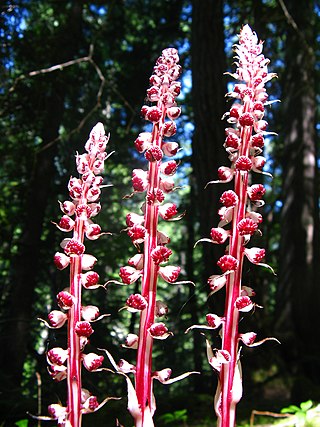
Allotropa virgata is in the family Ericaceae and is the only species of the genus Allotropa. It is a perennial plant that gets its common names from the distinct white and red or maroon stripes along its erect peduncle. A. virgata are nongreen as they lack chlorophyll, instead obtaining nutrition from neighboring green plants through a fungal intermediate.

Tricholoma equestre or Tricholoma flavovirens, commonly known as the man on horseback or yellow knight is a widely eaten but arguably toxic fungus of the genus Tricholoma that forms ectomycorrhiza with pine trees.
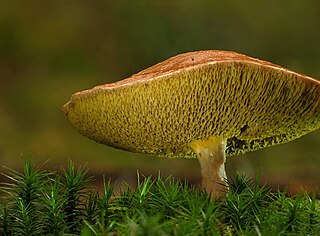
Suillus bovinus, also known as the Jersey cow mushroom or bovine bolete, is a pored mushroom of the genus Suillus in the family Suillaceae. A common fungus native to Europe and Asia, it has been introduced to North America and Australia. It was initially described as Boletus bovinus by Carl Linnaeus in 1753, and given its current binomial name by Henri François Anne de Roussel in 1806. It is an edible mushroom, though not highly regarded.

Tricholoma magnivelare, commonly known as the matsutake, white matsutake, ponderosa mushroom, pine mushroom, or American matsutake, is a gilled mushroom found East of the Rocky Mountains in North America growing in coniferous woodland. These ectomycorrhizal fungi are typically edible species that exist in a symbiotic relationship with various species of pine, commonly jack pine. They belong to the genus Tricholoma, which includes the closely related East Asian songi or matsutake as well as the Western matsutake and Meso-American matsutake.

Tricholoma pardinum, commonly known as spotted tricholoma, tiger tricholoma, tigertop, leopard knight, or dirty trich, is a gilled mushroom widely distributed across North America, Europe, and parts of Asia. It is generally found in beech woodland in summer and autumn. Two subspecies have been described from southern Europe. First officially described by Christiaan Hendrik Persoon in 1801, T. pardinum has had a confusing taxonomic history that extends over two centuries. In 1762, German naturalist Jacob Christian Schäffer described the species Agaricus tigrinus with an illustration corresponding to what is thought to be T. pardinum, and consequently, the name Tricholoma tigrinum has been used erroneously in some European field guides.

Tricholoma terreum, commonly known as the grey knight or dirty tricholoma, is a grey-capped mushroom of the large genus Tricholoma. It is found in coniferous woodlands in Europe, and has also been encountered under introduced pine trees in Australia and New Zealand. It is regarded as edible. A 2014 article speculated that it may be poisonous, but Sitta et al. in 2016 published in the same journal a counter article demonstrating the unfounded nature of such speculation.
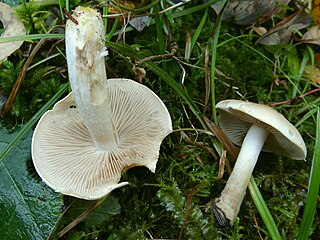
Tricholoma album, commonly known as the white knight, is an all-white mushroom of the large genus Tricholoma. It is found in Europe, India, and possibly North America. The cap and gills are white. The whitish stipe has no ring.

Tricholoma portentosum, commonly known as the charbonnier, streaked tricholoma, or sooty head, in North America, is a grey-capped edible mushroom of the large genus Tricholoma. It is found in woodlands in Europe and North America.
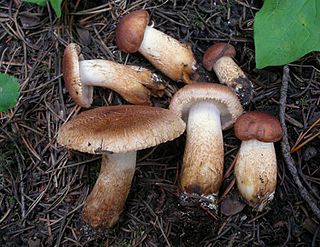
Tricholoma vaccinum, commonly known as the russet scaly tricholoma, the scaly knight, or the fuzztop, is a fungus of the agaric genus Tricholoma. It produces medium-sized fruit bodies (mushrooms) that have a distinctive hairy reddish-brown cap with a shaggy margin when young. The cap, which can reach a diameter of up to 6.5 cm (2.6 in) wide, breaks up into flattened scales in maturity. It has cream-buff to pinkish gills with brown spots. Its fibrous, hollow stipe is white above and reddish brown below, and measures 4 to 7.5 cm long. Although young fruit bodies have a partial veil, it does not leave a ring on the stipe.
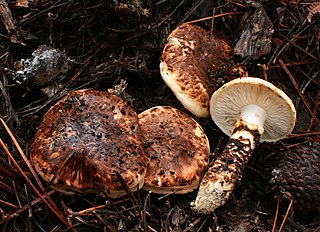
Tricholoma caligatum is a mushroom of the agaric genus Tricholoma. It is a large species with a distinct sheathing ring on the stem, found in mycorrhizal association with various trees throughout the Mediterranean. It is sometimes referred to as the European Matsutake, though it is certainly gastronomically inferior to the true Matsutake, a related species highly prized in Japan.
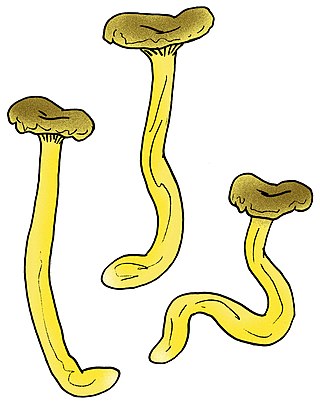
Cantharellus zangii is a species of fungus in the family Cantharellaceae. Described as new to science in 2012, it is found only in a small area in northwestern Yunnan, China. The fungus produces small, ochre to ochre-yellow fruit bodies (mushrooms) with thin flesh and a long tapering stipe. Microscopically, the mushroom features thin-walled hyphae with clamp connections, and large ellipsoid-shaped spores.
Trichoderma songyi is a species of fungus in the family Hypocreaceae. It is a soil-inhabiting fungus that associates with the pine mushroom, Tricholoma matsutake. Close relatives include Trichoderma koningii and T. caerulescens, from which T. songyi can be distinguished by differences in growth rate, the morphology of agar-grown cultures, and an odor similar to coconuts.

Mu Zang was a Chinese mycologist. He was known for his research on the Boletales of China, and the ecology and biogeography of fungi in southwestern China. He described more than 140 new species and circumscribed three genera, published more than 150 research papers, was chief editor or co-editor for twelve books, and wrote two monographs on the Boletaceae of China. His final book, "Dictionary of the Families and Genera of Chinese Cryptogamic (Spore) Plants" was co-authored with his wife, Professor Xinjiang Li.
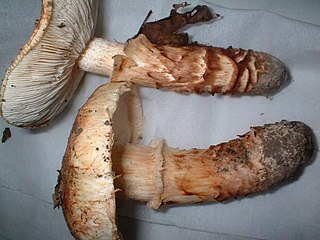
Tricholoma bakamatsutake is a mushroom of the agaric genus Tricholoma. Found in China and Japan, it was described as new to science by mycologist Tsuguo Hongo in 1974. It is closely related to the pine mushroom, Tricholoma matsutake, but occurs in Fagaceae forests rather than pine forests.

Tricholoma murrillianum is a gilled mushroom found west of the Rocky Mountains in North America growing in coniferous woodland. This ectomycorrhizal fungus is an edible species that exists in a symbiotic relationship with various species of conifer as well as tan oak and madrone. It belongs to the genus Tricholoma in the matsutake species complex, which includes the closely related East Asian songi or matsutake as well as the American matsutake and Mexican matsutake. T. murrillianum is also known as the ponderosa mushroom, pine mushroom, and Western matsutake.

Tricholoma robustum is an edible mycorrhizal mushroom in the family Tricholomataceae. In Japan it is called matsutake-modoki (pseudo-matsutake), and colloquially referred to as obasan no matsutake, because it resembles matsutake mushroom while being smaller and less aromatic and tasty.

















